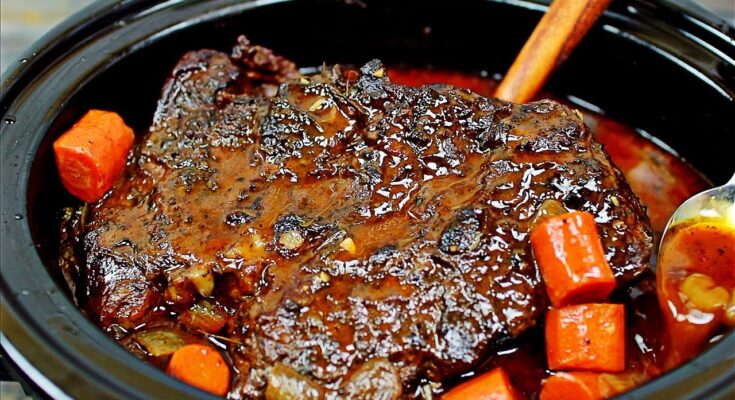Crock Pot Recipe: A Crock Pot, also known as a slow cooker, is one of the most beloved kitchen appliances for busy households. It’s an electric cooking pot designed to simmer food at a low temperature over a long period of time. Perfect for anyone who wants to prepare meals without having to hover over a stove, the Crock Pot handles the work for you while you go about your day. Just toss your ingredients in, set the temperature, and walk away.
What makes a Crock Pot different from other cooking methods is its consistent low heat, which slowly cooks the ingredients, allowing flavors to develop deeply. This is why it’s the go-to gadget for making stews, soups, pulled meats, and hearty dishes that taste like they’ve been bubbling on grandma’s stove all day.
Why Use a Crock Pot?
You might be wondering—what’s the big deal with slow cooking anyway? Well, it’s more than just convenience. Using a Crock Pot allows even the toughest cuts of meat to become fall-apart tender. It also requires minimal prep and monitoring, which means fewer dishes and less stress. Whether you’re cooking for one or feeding a crowd, Crock Pots are flexible, budget-friendly, and ideal for batch cooking.
They also help lock in moisture and retain nutrients better than high-heat methods, making your meals not only tastier but healthier. With the right recipe and a little patience, you’ll wonder how you ever cooked without one.
Benefits of Crock Pot Recipes
Time-Saving and Convenient
Let’s face it—we’re all busy. Between work, errands, and everything else life throws our way, it’s easy to grab takeout or microwave something quick. But with a Crock Pot, you can have a homemade meal ready and waiting without spending hours in the kitchen. You can prep your ingredients the night before or early in the morning, and by dinner time, you’ll have a flavorful dish ready to serve.
This “set it and forget it” style of cooking is perfect for people with hectic schedules. Imagine coming home to the delicious aroma of a hearty beef stew or a creamy chicken curry simmering gently in your Crock Pot. It’s like having a personal chef that works quietly while you’re busy doing other things.
Enhances Flavor Over Time
The magic of a Crock Pot lies in its slow, steady heat. As ingredients simmer for hours, their flavors mingle and intensify, resulting in rich, savory meals. Unlike fast cooking methods where you need to constantly adjust seasoning or worry about burning, Crock Pots allow everything from herbs and spices to meat and veggies to release their full flavor potential naturally.
This is why dishes like chili, soups, and braised meats taste even better the next day—they’ve had time to soak up all the goodness. It’s low and slow, and oh-so-delicious.
Energy-Efficient Cooking
Did you know that Crock Pots use way less electricity than your oven or stovetop? A typical slow cooker uses only about 200 watts per hour on the low setting, which is a huge energy saver. That means you can cook for hours without running up your electric bill.
Plus, during the hotter months, using a Crock Pot keeps your kitchen cool—no more sweating over a hot stove. It’s a win-win situation: tasty food, energy saved, and comfort maintained.
Essential Tools and Ingredients
Choosing the Right Crock Pot
Not all Crock Pots are created equal. When picking the right one for your kitchen, consider the size, features, and your cooking needs. If you’re cooking for a large family or love leftovers, go for a 6-8 quart model. For singles or couples, a 3-4 quart Crock Pot should do just fine.
Some modern models even come with programmable timers, warming functions, and digital controls. These features allow you to set the exact cooking time and temperature, giving you even more control over your meals. Keep in mind that a round Crock Pot is great for soups and stews, while an oval one is better for roasts and whole chickens.
Pantry Staples for Crock Pot Recipes
To make the most out of your Crock Pot, stock your pantry with essentials that are frequently used in slow cooker recipes. These include:
- Canned tomatoes (diced, crushed, or paste)
- Broths and stocks (chicken, beef, veggie)
- Beans and lentils
- Rice and pasta
- Herbs and spices (paprika, thyme, oregano, garlic powder, etc.)
- Soy sauce, Worcestershire sauce, and balsamic vinegar
Having these basics on hand means you can throw together a delicious Crock Pot meal even on short notice.
Must-Have Fresh Ingredients
In addition to pantry staples, a well-stocked fridge will take your slow-cooked meals to the next level. Think fresh vegetables like onions, carrots, celery, bell peppers, and potatoes. For proteins, chicken thighs, beef chuck, pork shoulder, and ground turkey are all fantastic in the Crock Pot.
Don’t forget fresh herbs for garnishing—parsley, cilantro, and green onions add a burst of flavor and color to your finished dish.
Step-by-Step Crock Pot Chicken Stew Recipe
Step 1: Gather Your Ingredients
Here’s what you’ll need for a simple, hearty chicken stew:
- 1.5 lbs boneless, skinless chicken thighs
- 3 carrots, chopped
- 3 potatoes, diced
- 2 celery stalks, chopped
- 1 onion, diced
- 3 garlic cloves, minced
- 1 tsp dried thyme
- 1 tsp paprika
- Salt and pepper to taste
- 4 cups chicken broth
- 2 tbsp olive oil
- Optional: 1 cup frozen peas
Make sure to chop and measure everything beforehand. Mise en place is key!
Step 2: Prep the Ingredients
Start by browning the chicken in a skillet with olive oil. This step is optional but adds depth to the flavor. Once browned, transfer the chicken to the Crock Pot. Next, sauté the onions and garlic until fragrant—about 2-3 minutes. Toss them in with the rest of the veggies.
Season everything with thyme, paprika, salt, and pepper.
Step 3: Layer Ingredients in the Crock Pot
Now comes the fun part—layering! Start by placing the chopped carrots, potatoes, and celery at the bottom of the Crock Pot. These root vegetables take longer to cook, so putting them at the bottom ensures they get the most heat. Next, add your sautéed onions and garlic over the veggies.
Place the browned chicken thighs on top. Pour the chicken broth evenly over everything until the ingredients are just covered. Give it a gentle stir to combine the flavors, but don’t mix too much—you want those layers to do their thing. Cover with the lid and move on to the next step.
Layering is essential in Crock Pot cooking. It ensures that every ingredient cooks at the right pace and soaks in the maximum flavor. For example, putting delicate ingredients like peas or fresh herbs too early can lead to mushiness, so those go in at the end.
Step 4: Set the Timer and Let It Cook
Time to let the Crock Pot work its magic! Set it to low for 7-8 hours or high for 4-5 hours, depending on your schedule. Low and slow is always better for flavor and tenderness, but the high setting is great when you’re short on time.
During cooking, resist the urge to lift the lid—every time you do, heat escapes, and it extends the cooking time. Trust the process and let it simmer undisturbed. As the hours pass, your home will start to smell absolutely incredible.
With just a few hours of gentle cooking, the chicken will become juicy and fork-tender, while the vegetables soften to the perfect consistency. About 30 minutes before serving, you can stir in a cup of frozen peas for a pop of color and sweetness.
Step 5: Serve and Enjoy
Once everything is cooked to perfection, it’s time to serve. Use a ladle to scoop out hearty portions into bowls. Garnish with fresh parsley or a sprinkle of cracked pepper. Pair it with some crusty bread or a simple side salad, and you’ve got yourself a comforting, complete meal.
This chicken stew is a hug in a bowl—warming, flavorful, and satisfying. Plus, it makes excellent leftovers! Store any extras in an airtight container in the fridge for up to 3 days, or freeze for longer storage. It’s meal prep made easy.
Tips for Perfect Crock Pot Cooking
Don’t Overfill the Pot
One common mistake in Crock Pot cooking is stuffing it to the brim. This can affect the way heat circulates and prevent the food from cooking evenly. Aim to fill your Crock Pot no more than two-thirds full, especially for recipes with liquids. This allows everything to simmer properly without spilling over or undercooking.
If you’re unsure about portion sizes, refer to your Crock Pot’s manual. It usually offers guidance on the maximum capacity for both solid and liquid ingredients.
Keep the Lid Closed
Yes, we’ve mentioned this already, but it’s worth repeating: keep that lid on! Every peek you take lets out vital heat and moisture, setting your cooking time back by 15 to 20 minutes each time. Crock Pots are designed to build and maintain heat under that snug-fitting lid. Let it do its job without interruptions.
Instead of checking visually, set a timer and trust the process. You can always check the doneness at the final hour if you really need to adjust anything.
Adjust Seasonings at the End
One trick to leveling up your Crock Pot game is seasoning your food in layers. Start with a base of herbs and spices at the beginning, but wait to adjust salt, pepper, or acids like lemon juice or vinegar until the end of cooking. That way, you avoid over-salting or dulling flavors during the long cook time.
Once your dish is ready, give it a taste test and add any final touches to brighten or balance the flavor.
Creative Crock Pot Variations to Try
Crock Pot Vegetarian Chili
Who says you need meat to enjoy a hearty meal? A Crock Pot vegetarian chili is a comforting and protein-packed dish that’s perfect for meatless Mondays or everyday healthy eating. Combine black beans, kidney beans, chickpeas, corn, tomatoes, bell peppers, onions, and a medley of spices like cumin, smoked paprika, and chili powder. Let it cook on low for 6-8 hours, and boom—you’ve got a thick, flavorful chili bursting with texture and nutrition.
Top it with shredded cheese, sour cream, or avocado slices for that extra punch. It’s also a great recipe to double and freeze for future meals. Trust me, no one will miss the meat.
Crock Pot Beef Stroganoff
For a creamy, indulgent comfort food classic, Crock Pot beef stroganoff is where it’s at. Tender chunks of beef stew meat, mushrooms, and onions slow-cook in a rich beef broth with garlic and thyme. Once everything is melt-in-your-mouth tender, stir in sour cream and cream cheese for that iconic tangy flavor.
Serve it over egg noodles or rice, and you’ve got a timeless family favorite with minimal effort. It’s fancy enough for dinner guests and easy enough for a Tuesday night.
Common Mistakes to Avoid in Crock Pot Cooking
Adding Dairy Too Early
Adding ingredients like milk, cream, or cheese at the beginning can lead to curdling and a weird texture. Dairy should always be stirred in during the last 30 minutes of cooking to keep it smooth and creamy. This applies to recipes like creamy soups, cheesy dips, and stroganoff.
Want it extra rich? Mix a bit of cornstarch with cold water to thicken the sauce before adding your dairy.
Using the Wrong Cut of Meat
Lean cuts like chicken breast or pork loin tend to dry out in a Crock Pot. Instead, opt for tougher, fattier cuts like chicken thighs, beef chuck, or pork shoulder. These become succulent and tender after slow cooking. Not only do they hold up better, but they’re usually cheaper too. Bonus!
Neglecting to Brown Meats
While it’s tempting to skip the browning step, don’t do it! Browning meat adds a rich, savory depth to your Crock Pot recipes. The caramelization you get from searing meat is a game-changer, especially for stews, chili, and roasts. Just a few extra minutes in a skillet pays off big time in flavor.
Storing and Reheating Leftovers
Refrigeration Tips
Let your Crock Pot meal cool to room temperature before storing. Divide leftovers into airtight containers and refrigerate within 2 hours. Most Crock Pot meals last 3-4 days in the fridge. For soups and stews, separating solids and liquids can help preserve texture.
Freezing for Later
Most Crock Pot meals freeze beautifully. Store in freezer-safe containers or zip-top bags, label with the date, and freeze for up to 3 months. Thaw overnight in the fridge or gently reheat from frozen.
Pro tip: Freeze flat in zip-top bags to save space and speed up thawing.
Reheating Best Practices
For best results, reheat Crock Pot leftovers on the stovetop over medium heat, stirring occasionally. You can also microwave in short bursts, stirring between each. If the meal looks too thick, add a splash of broth or water to revive it.
FAQs about Crock Pot Recipes
Q1: What is a Crock Pot?
A Crock Pot is a type of slow cooker that uses low heat over a long time to cook meals. It’s perfect for tender meats, stews, soups, and busy schedules.
Q2: Do I need to brown meat before adding it to the Crock Pot?
Not always, but browning adds flavor and improves texture. For beef or pork, searing first is worth the extra step.
Q3: Can I cook frozen meat in a Crock Pot?
It’s not recommended. For food safety, always thaw meat before slow cooking to avoid uneven cooking or bacteria growth.
Q4: What’s the difference between high and low settings?
Both settings cook to the same temperature—low just takes longer. Use “Low” for all-day cooking and “High” when you’re short on time.
Q5: Do I need to stir food in a Crock Pot?
Nope! Unlike stovetop cooking, stirring isn’t necessary. In fact, lifting the lid too often lets heat escape and slows down cooking.
Q6: Can I leave a Crock Pot on while I’m not home?
Yes! Crock Pots are designed to cook safely unattended. Just place it on a heat-safe surface and keep cords away from water.
Q7: How do I clean a Crock Pot?
Let it cool, then soak the insert in warm soapy water. Some inserts are dishwasher-safe—check the manual to be sure.
Conclusion
Cooking with a Crock Pot is one of the easiest, most satisfying ways to get a homemade meal on the table without breaking a sweat. Whether you’re throwing together a savory chicken stew, prepping a meatless chili, or diving into a creamy stroganoff, your Crock Pot has your back. It’s a time-saver, a flavor-enhancer, and a game-changer for busy cooks everywhere.
So go ahead—dust off that slow cooker, stock up on your favorite ingredients, and get cooking. Once you taste the results, you’ll wonder how you ever lived without it. Happy slow cooking!



